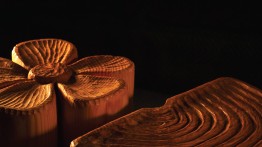Nik Gelormino A'08

When sculptor Nik Gelormino arrived at The Cooper Union in 2004, he’d been making drawings and paintings. Thanks to the School of Art’s philosophy that encourages students to use a wide range of media for expression, he began to write plays with classmate Keegan Monaghan A'08, and then perform them. “It opened my process up to the idea of collaboration as well as improvising in real time.” That collaboration also led more directly to the work he does today: “The plays began as a way to justify making sculptures in the form of 'props'. These sculptures or props were imbued with a purpose and a function. They served a role in the narrative of the play.”
Gelormino still plays with that line between function and pure aesthetics. The sculptor, whose central medium is wood, points out that an object’s function is largely a matter of subjective judgement: “I often think about the way a rock could be used as a chair, or an anchor, or a doorstop and yet on its own a rock is just a rock with no predetermined function. We ascribe functionality to objects, and this usually reflects more about our expectations than the work itself.”
Gelormino, who studied with master woodcarver Yo Takimoto, creates pieces that reveal images within the natural lines of a cross section of wood. The scale of his sculptures vary—from stool-sized pieces to grand, sculpted slabs that can work as doors.
A native of Orange County, California, he returned west—this time to Los Angeles— eight years after graduation. The wood he uses primarily comes from California. “This is a conscious decision, in part because I want my work to reflect some aspect of the place where it's made. I try to keep things simple in my studio and limit unnecessary decisions. One way I do this is by using material that is readily available and abundant. Almost all my material comes from trees taken down due to drought, disease, fire, or weather events.” While wood remains his primary medium, he’s been working more with metal, especially for doorknobs and cabinet pulls that are carved in wood and then cast in brass.
He doesn’t consider himself a furniture designer but an artist whose work skates the line between sculpture and functionality. “I think of the 'functional' aspect of my work as a prompt to explore new forms and ideas and I try to remain open to improvising with the natural qualities of wood.”




